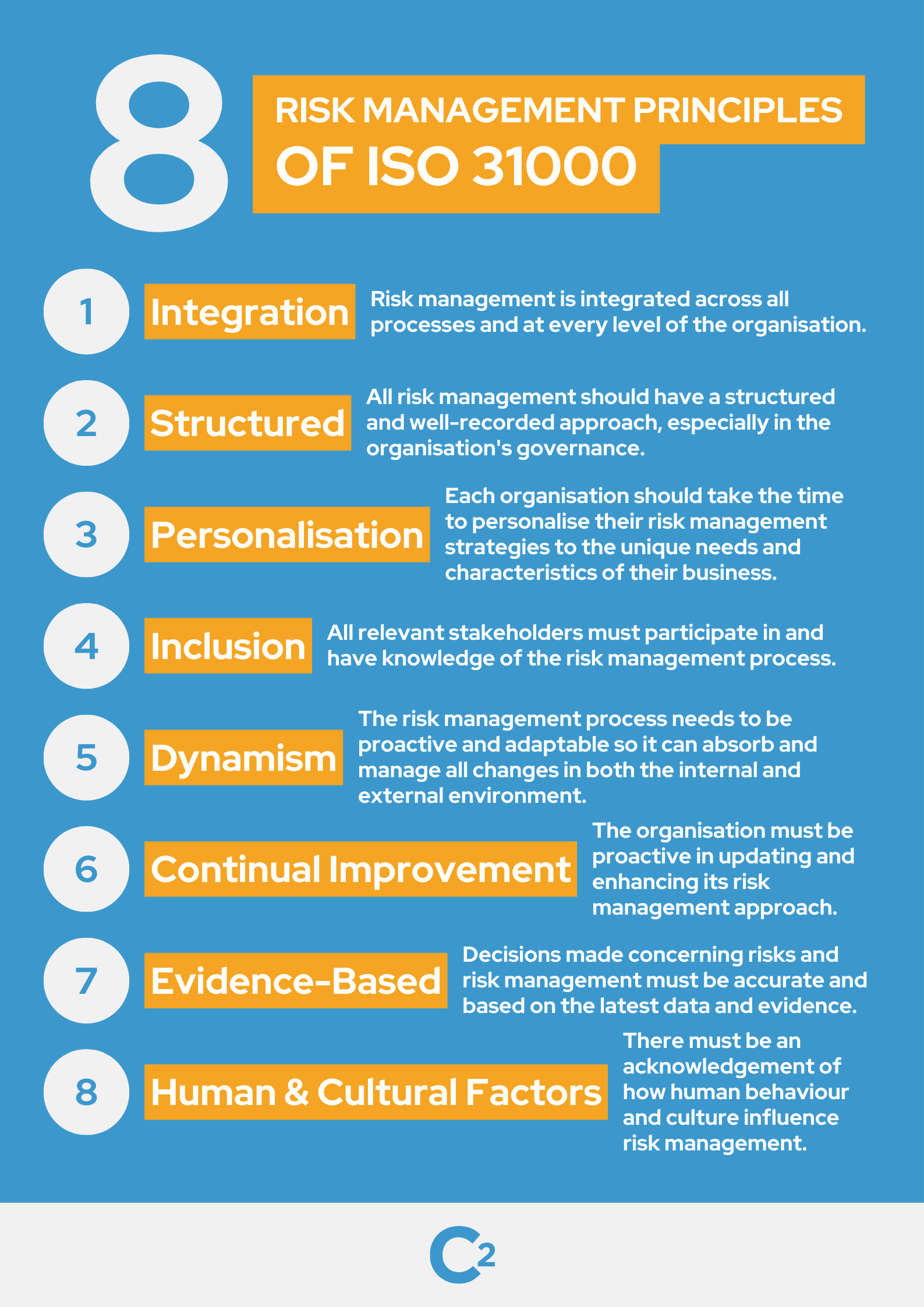What is ISO 31000 Risk Management Standard?
Published on December 10, 2024
Last updated on December 10, 2024
Jump to a section
Risk management forms an important part of business operations. Employees need to be able to identify, mitigate, and manage risks as they surface. Standards such as the ISO 31000 provide guidelines and principles to best help companies manage risk effectively.
ISO 31000 is designed to be used by organisations of all sizes, from small to international, and equally for the public, private, and nonprofit sectors. It was developed by the International Organization for Standardization (ISO) and was first published in 2009, with the latest update being published in 2018.
What is the purpose of ISO 31000?
ISO 31000 and other standards like it provide a single agreed set of guidelines and practices for a systematic approach to risk assessment, treatment, and management. This means that risk analysis and treatment practices are standardised at an international level so organisations across the world all maintain the same risk management approach.
Risk management practices are designed to help companies protect their assets and properties, reasonably achieve their objectives, and make good decisions all while remaining compliant with regulations across multiple jurisdictions.
What is the structure of ISO 31000?
The ISO 31000 standard is best explained through an examination of its 3 main components: its principles, risk management framework, and overall risk management process. However, it is important to note that each of these components does not stand alone but rather is interwoven together to provide a strong and coherent approach to risk management activities.
What are the principles of ISO 31000?
ISO 31000 introduces 8 principles that must be outlined for companies to adhere to the standard correctly. These principles aid companies in identifying risks, evaluating the probability of risks in specific events, and determining the severity of problems caused by those events and their risks taking place.
The goal of the standard is not to eliminate risk, but to aid in their identification. It also gives clear strategies and standardisation to the approach needed to mitigate and reduce risk.

The 8 risk management principles of ISO 31000 are:
1. Integration: Risk management is integrated across all processes and at every level of the organisation.
2. Structured: All risk management should have a structured and well-recorded approach, especially in the organisation's governance.
3. Personalisation: Each organisation should take the time to personalise their risk management strategies to the unique needs and characteristics of their business.
4. Inclusion: All relevant stakeholders must participate in and have knowledge of the risk management process.
5. Dynamism: The risk management process needs to be proactive and adaptable so it can absorb and manage all changes in both the internal and external environment.
6. Continual improvement: The organisation must be proactive in updating and enhancing its risk management approach.
7. Evidence-based: Decisions made concerning risks and risk management must be accurate and based on the latest data and evidence.
8. Human and cultural factors: There must be an acknowledgement of how human behaviour and culture influence risk management.
What is the risk management framework of ISO 31000?
The framework of ISO 31000 creates the structure to run through the organisation. Every part of the business needs to be aware of the framework for best risk management practices to be embedded at every level. Ideally, a risk management framework should include:
1. Leadership and commitment: Top management should support and lead the risk management process.
2. Integration: Ensures risk management is part of all organisational processes, from operations and strategy down to everyday tasks.
3. Design: Establishes the framework with an understanding of the organisation's context, defining roles, and resource allocation.
4. Implementation: Putting the designed framework into action.
5. Evaluation: Regular revisits to ensure the framework is still effective.
6. Improvement: Continuously enhancing the risk management framework based on feedback and changing circumstances within the company and industry.
Breaking down the ISO 31000 risk management process
The process for maintaining the ISO 31000 framework should be quite straightforward to manage, but all stakeholders need to understand it so it can be implemented correctly.
While processes may look a little different from company to company, there should be 3 major steps that emerge from any strategy. They are as follows:
1. Active communication: Wherein all necessary personnel can communicate and consult with one another, especially during an emergency.
2. Process execution: Wherein the full process of risk management is conducted:
- Establishing the context of the risk
- Risk identification
- Risk analysis
- Risk evaluation
- Risk treatment
3. Response: Wherein regular monitoring and review allows for updates to be applied and timely responses to be crafted and shared.
What are the benefits of implementing ISO 31000?
Implementing any risk management policy like ISO 31000 will always carry benefits for a business. Establishing a risk management process based on a framework created by subject matter experts will carry foundational weight and will account for any number of risk criteria. Companies may also enjoy the following benefits:
Improved decision-making
Making a decision during a risk event can be stressful and difficult. Self-doubt can creep in and block executives from being confident in their choices. Setting up a solid risk management framework based on ISO 31000 gives personnel confidence that every decision they make will be the right one.
Regulatory compliance
All businesses must execute business processes in line with the established requirements of regulatory bodies in their countries of operation and specific industries. Choosing to adhere to standards such as ISO 31000 allows organisations to guarantee that they are compliant with expectations and regulations. The framework will also provide them with a confirmed trail of evidence they can use to prove their compliance if they must submit to an external audit.
Protection of reputation and wider assets
Reputation is everything in the world of business. Repeated events can damage the reputation of a business in the long term, and may also lead to the loss of both new and existing clients. Additionally, events may lead to the loss of business assets ranging from supplies or products through to experienced staff, making it difficult for business operations to continue as normal. Standards such as ISO 31000 exist to help workers identify and protect against risk to prevent damage to reputation and assets if possible.
Is ISO 31000 certifiable?
No, unlike other risk management standards, ISO 31000 is not certifiable. This standard only serves as good practice guidelines to help build a robust risk management program.
Regulatory bodies will not ask for proof of accreditation as they would with other standards. However, businesses can use ISO 31000 as a benchmark to ensure that their current enterprise risk management systems are up to date and able to handle any event that may come to pass.
Ensure compliance with Continuity2
Risk management always needs to be taken seriously. Having robust risk treatment strategies on hand is imperative as risk events do occur, no matter how proactive a company might be in prevention. Risk assessment techniques can only take you so far; employees need clear guidance on what to do before, during, and after a risk event has been identified.
Continuity2's Meridian BCMS centralises all information on any risk management protocols within the company and makes it easy for the right people to access the information they need to report and respond to incidents. Remain compliant with regulatory demands and integrate risk management across every level of your organisation today.
Good risk management requires a cohesive and proactive approach. Book a demo today to find out how Continuity2 can help you remain compliant and able to actively manage the risks to your systems.
Written by Donna Maclellan
Lead Risk and Resilience Analyst at Continuity2
With a first-class honours degree in Risk Management from Glasgow Caledonian University, Donna has adopted a proactive approach to problem-solving to help safeguard clients' best interests for over 5 years. From identifying potential risks to implementing appropriate management measures, Donna ensures clients can recover and thrive in the face of challenges.


Written by Donna Maclellan
Lead Risk and Resilience Analyst at Continuity2
With a first-class honours degree in Risk Management from Glasgow Caledonian University, Donna has adopted a proactive approach to problem-solving to help safeguard clients' best interests for over 5 years. From identifying potential risks to implementing appropriate management measures, Donna ensures clients can recover and thrive in the face of challenges.